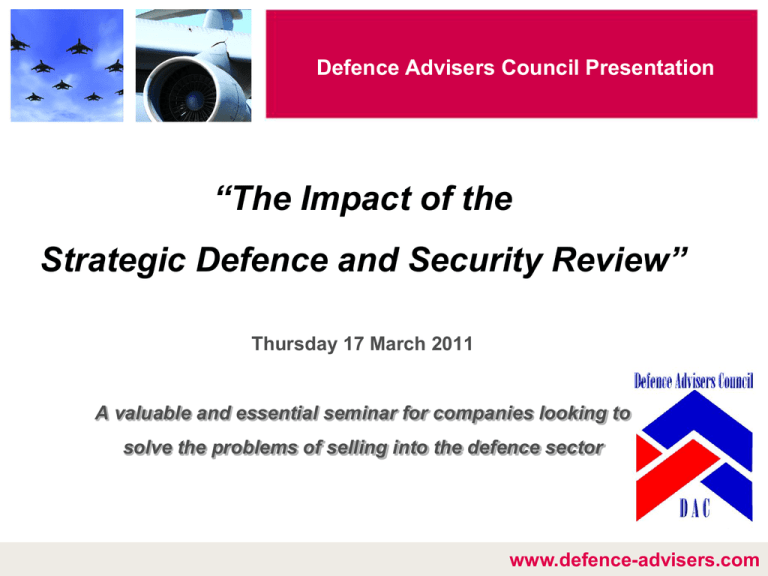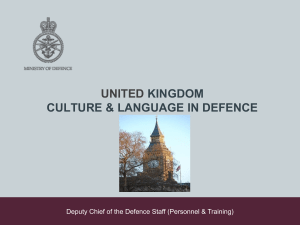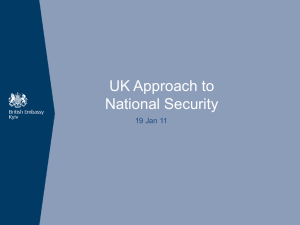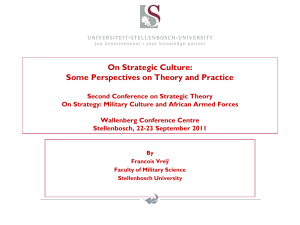FAC Presentation - Defence Advisers Council
advertisement

Defence Advisers Council Presentation “The Impact of the Strategic Defence and Security Review” Thursday 17 March 2011 A valuable and essential seminar for companies looking to solve the problems of selling into the defence sector www.defence-advisers.com SDSR THE HEADLINES “£38 bn Budget hole at the MoD” “Future carriers – saved but delayed” “Nimrods – Scrapped” “Harriers and Ark Royal decommissioned” “MoD to name shame contractors” UK Defence Industry • Europe’s largest (20% market share) • Worth over £30bn in 2010 • MOD ~ UK industry’s #1 Customer ~ 23,000 contracts annually ~ 200,000 Service personnel (almost)! The Defence Advisers Council (DAC) The Defence Advisers Council AGENDA 09.00 Arrival, registration, coffee 09.30 Welcome & Introduction 09.40 The Impact of the Strategic Defence & Security Review 10.30 Mitigating risks to future business (Part 1) 11.00 Coffee 11.30 Mitigating risks to future business (Part 2) 12.00 Enhancing Capabilities & Competencies 12.45 Q&A 13.00 Networking buffet lunch 14.00 One-to-One meetings with presenters 1600 Depart UK Defence Industry BUT……..there has been the: Strategic Defence and Security Review (SDSR) What does the Strategic Defence and Security Review mean for the Aerospace and Defence Industry? Background • Aerospace and Defence sector have been under pressure due to the global economic environment. • SDSR focuses on industry specific issues: - need to increase operational efficiency - cut costs - diversify and globalise to survive. • MOD will be looking to increase and broaden the provision of support services. • Few surprises, but difficult decisions still to be made. • Detailed planning required to balance the books and avoid pushing the problem out to the right, or reducing flexibility. Secretary of State for Defence Policy Principles 1. Operational commitments are top priority and must be conducted effectively. 2. Strategic Defence & Security Review will be cross-Government, policy-led and resource informed. 3. Core of UK security will remain NATO; US will be our major partner and bi-lateral co-operation with France will be stepped up. 4. MOD’s relationship with defence industry will be reset and Government will proceed with acquisition reform. Is this a storm Industry can ride out? • Big players with diversified products and global opportunities will remain well placed • Civil side recovering well since 2009 • M & A expected to increase as bigger players look to manage risk in the supply chain • Larger players could be exposed if suppliers are over reliant on UK defence market • Big contractors have had close contact with MoD – too close? • Smaller providers may not have same visibility and may not have such a good understanding of the requirements for survival. So what does it mean for potential suppliers to the Defence Sector? 1. Opportunities to provide cost savings for MOD Procurement. 2. Opportunities to buy up parts of MOD which they are offloading. 3. Opportunities for M&A activity as Primes look to consolidate. Working together to procure equipment better • How we see it : Industry already diversifying and globalising, the military is under the most pressure to change. • Budgets have shrunk and provider base may shrink too . • Suppliers will look to other markets. • MoD needs its equipment suppliers to offer more by: - decreasing their margins - taking on more risk - accepting more responsibility for R&D - expanding their services to cover “models” such as availability contracting & maintenance and support. • MoD needs a more commercial focus, faster & more flexible contracting and a more holistic approach eg through life expenses. Contract Renegotiations • Very clear signal from the Prime Minister that contract renegotiations will be a strong focus. • MoD is expected to save £4.7bn from reducing the defence estate, civilian headcount and allowances, (and renegotiating contracts). • Not yet clear how much of that is expected to come out of the margins of suppliers. • BUT…. Industry can expect to face a Customer : - adopting “a much more aggressive drive for efficiencies” - looking to write significant amounts off existing contracts. A new range of services bring opportunity • New opportunities are likely to attract increased interest • Areas likely to be on the table include facilities management , equipment maintenance and training • Some demand likely to be met by larger business service providers who operate in other sectors • Expect some mergers in the market • Not many start ups, as scale and robustness required and cost of entry likely to be high - therefore look at increased partnering, JVs etc • Offering these services will require a more customer-centric culture than before. Risk • Some industries might look to have come through relatively unscathed, but beware complacency. • Need to balance short term crisis management and long term ambition. • Strategic ambitions likely to be dependent on military operations being scaled back in Afghanistan by 2015, to create the headroom necessary to realise the vision for 2020. • If we are still in Afghanistan at the time of the next CSR, industry can expect a similarly challenging focus on budget cutting. • BUT…the difficult work of deciding the detail of “how” to reduce costs is yet to be done. And these “how” decisions will impact on defence suppliers. What should industry do? • Expect to see similar budget cuts from defence reviews across the world. • Diversifying into other markets won’t mean the pressure on price will disappear. • Next UK review is in 5 years. • Many cost cutting projects have been initiated in industry already. • Bigger players should consider more transformational corporate simplification programmes. • For those who have made acquisitions, consolidation and standardisation across entities, properties and processes will support efficiency, effectiveness and agility improvements. What should industry do? • We recommend: - Now is the time to review your strategy, aims and objectives - Make your structures/models agile enough to deliver the efficiencies required, as existing contracts come under price pressure - Realign your market focus - Therefore ….revisit your overarching business planning and the operational model supporting it. • Knock-on effects likely to be: - A requirement for improved customer service - An ability of the workforce to deliver new services - The capability to up-skill to meet any gaps. BUT - Life goes on ... • Existing contracts will need strong programme management and governance. • New contracts can expect even stronger government/customer focus. • Delivering to time and on budget critical. • Governance will be important. The new bribery bill: pressure will increase in a sector where anti bribery and corruption compliance has always been key. • Still a big sector with lots opportunity. • Competitive advantage will be important, all aspects of operational and financial efficiency should be scrutinised. The Defence Advisers Council (DAC) STRATEGY & PLANNING WHY PLAN? “By failing to prepare, you are preparing to fail” Benjamin Franklin “The nice thing about not planning is that failure comes as a complete and utter surprise and is not preceded by long periods of worry, anguish and self-doubt.” THE OPTIONS OPTION 1 – The Business Miracle “Do today what you did yesterday and expect a different result tomorrow.” THE OPTIONS OPTION 2 – Manage The Future: Produce a Road Map Define your Vision Identify your Objectives Set your Goals/Targets Create a Strategy Make a Plan Communicate your Actions Acquisition Operating Framework “The AOF is the authoritative source of policy and good practice for all members of the MOD and our Industry partners concerned with acquisition” • • • • • • • • • • • • Strategy Considerations Invitation To Tender Tendering And Contract Award Contract Administration Alliancing Conflicts of Interest Due Diligence Influencing the Supplier Network More Effective Contracting Partnering Private Finance Initiatives Public Private Partnerships www.aof.mod.uk KEY MESSAGES 1. Prepare and Plan …………………………….…. think strategically 2. Define your company’s products/services … clearly 3. Determine why MOD should buy from you … “USP” 4. Decide on your ‘routes to market’ …………… the tactics 5. Identify your ‘strategic’ funding options …… rationally 6. Organise Strategy Reviews …………………… regularly James Short 07818 054645 james.short@augmentor-uk.com The Defence Advisers Council (DAC) Supply Chain Management & Development Submarine Solutions Irshad Booly MCIPS MILT Supply Chain Project Leader/Manager Supplier Management in BAE Systems • Within BAE Systems we take a tiered approach to supplier management, ranging from full strategic and operational performance partnerships with our most strategic major suppliers to performance management with our general supply base. • We use the SBAC 21st Century Supply Chain Programme - SC21 tools and techniques for operational performance management and improvement with our suppliers. • We recognise improvement in performance is dependent upon open communication and clear improvement plans which must be two way to be effective. Integrated Supplier Management Fragility Study Category 1 COTS or near – easy to change Non Critical Category 2 Category 3 Critical equip to Less critical boat integration 43 suppliers items that are Cost/ Qualification/ Expensive in availability not Time/Cost to normally an issue change supplier Category 4 Critical equipment Or materials that would require extensive development to change Category 4 Sources - The Situation today Of the 43 sources identified in this category: • 22% assessed as financially at risk • 65% stated products unique to Submarines • 26% stated processes unique to Submarines • 16% stated resources unique to Submarines Integrated Supplier Management Process Fragility Study Supplier Performance Review QBR SC21 Supplier Management and Development Supplier Forums Category Management 2 Year Improvement Plans PPA Fragility Study looks at: • Section 1 - Organisation Structure • (Contacts, Ownership Structure) • Section 2 - Industry & Markets • (% T/O to Naval, Other Markets, Exchange Rate) • Section 3 - Product Profile • (Technology, Obsolescence,) • Section 4 - Staff & Employment Profiles • (Balance of Skills, Retention, Training) • Section 5 - General Opinions & Influences • (Relationship, Defence Environment & Impact) SC21 is an industry change programme designed to accelerate the competitiveness of the aerospace & defence industry by raising the performance of its supply chains. • It is a national strategy, executed regionally SC21 National Progress – 600+ companies now signed up including MoD – Implementation phase underway : >200 companies actively engaged in multiple customer working groups - 65 Self Starters added to the national plan since Jan 09 – Regional aerospace partners have now secured collectively over £8m to roll out SC21 across the country – steering groups established. – Twelve (12) recognition awards made to date – 12 months continuous world-class performance – Trials commenced on joint customer technical oversight of suppliers – SC21 is linked with technological innovation through the A&D Knowledge Transfer Network (KTN) – Ethics – one of the seven key commitments : each SC21 signatory has been asked to sign the Common Industry Standard Ethics document. SC21- Supply chains for 21st Century 1. Accreditation and quality improvement: 3. Relationships: Initially SC21 will implement 3 action streams to drive early transformation and improvement need to remove repetition, and unnecessary duplication Need for better end-to-end communication and collaborative planning RMM/PPA AS/EN9100 2. 4. Innovative Supply Chains Creation of Partnerships & Collaborations to add value to customers & E business BAE Systems – PPA/SPR Development and performance: need increased efficiency and remove waste Manufacturing Excellence Business Excellence 5. Through life capability management What will the three work streams achieve? Reduced auditing through recognition of supply chain certification Recognise and accept certification to AS/EN9100 (or equivalent) Encourage special process approval to Nadcap Reduced quality visits through co-ordination between customers quality teams A consistent approach to supply chain development and performance measurement Remove duplication of supply development programmes – achieve 80% commonality Use common metrics (KPIs) Key Performance Indicators Improved supply chain relationships Objective measurement of relationships using the RMM Relationships workshops to facilitate improvement Creating a relationship platform to address and progress the accreditation and development work streams Enablers to support development from Build to Print to TLCM Platform assembly Past Emerging Future OEMs System Integrators System Integrators Large scale integration Small scale integration Value – added parts & assemblies Evolution of the Supply Chain to Supply Networks - TLCM Make-to-print parts & assemblies Raw materials •Primarily direct supply •Many “supplier paths” •Fewer “supplier Paths” •Many direct suppliers •Fewer, still many direct suppliers •Fewer direct suppliers •No real role for “integrators” •Limited role for “integrators” •Larger role for value adding suppliers •Extensive role for “integrators” •Larger role for value adding parts suppliers Value Added Regional funding for the Aerospace & Defence Industry 2010 North West: Aerospace Alliance: ADS Northern Ireland ADS Scotland: Northern Defence Industries North East + Yorkshire: East of England Midlands Aerospace Alliance: Aerospace Wales Forum: ADS Project office: National oversight and co-ordination of the programme Farnborough Aerospace Consortium: West of England Aerospace Forum: REGIONAL POINTS OF CONTACT REGION RTA Point of Contact SOUTH EAST FAC Kim Yeomans SOUTH WEST WEAF Barry Warburton WEST MIDLANDS MAA Tim Holmes EAST MIDLANDS MAA Tim Holmes NORTH WEST NWAA Martin Wright NORTH EAST NDI Robin Fox NORTHERN IRELAND A|D|S Northern Ireland Ian Watson WALES SCOTLAND Aerospace Wales Forum Paul Lindsay A|D|S Scotland Ian Watson e-mail kim.yeomans@fac.org.uk barry@weaf.co.uk tim.holmes@midlandsaerospace.org.uk tim.holmes@midlandsaerospace.org.uk martin.wright@aerospace.co.uk robin.fox@ndi.org.uk ian.watson@adsgroup.org.uk paul@aerospacewales.aero ian.watson@adsgroup.org.uk For Further Information and to sign up for SC21: Visit : Aerospace/Defence/Security (formerly SBAC) www.sbac.co.uk A|D|S is the trade body advancing UK AeroSpace, Defence and Security Industries ASTUTE BOAT 1 “SUCCESS IS ACHIEVED THROUGH A STRUCTURED PROGRAMME ALIGNED WITH A COLLABOARTIVE AND CAPABLE SUPPLY CHAIN” First in Class Astute exits Barrow 15th November 2009 “It is not the strongest species that survive, nor the most intelligent, it is the ones most responsive to change” The Defence Advisers Council (DAC) Crossing the legal minefield Richard Brown, Aerospace & Defence Farnborough Aerospace Consortium 17 March 2011 Lawyers & Parliamentary Agents Crossing the legal minefield Richard Brown Aerospace & Defence Sector Veale Wasbrough Vizards - Lawyers to MoD/Primes/Defence supplier - Defence Advisers Council - Farnborough Aerospace Consortium Helpline Crossing the legal minefield Key messages for today: SDSR will impact on your contracts Get your contract right Avoid the mines! Defence buyers want suppliers to collaborate Crossing the legal minefield Impact of the SDSR on defence contracts: Can defence buyers cancel a contract? Can prices be renegotiated if a contract has been signed? Can a defence buyer require a supplier to offer more for less? What legal documents? Defence standards (DEFSTANS) Defence forms (DEFFORMS) Defence conditions (DEFCONS) Contracts with the Primes MoD contracts Strategic Defence & Security Review Cancellation rights? MoD Defence Conditions DEFCON 534: Prompt payment • Credit period for your suppliers = 30 days • Credit period for MoD = 60/90/120 days DEFCON 566: Change of control • Duty to advise MoD • Effect on possible sale • Mergers and Acquisitions Section MoD Defence Conditions DEFCON 703: Intellectual property rights • What are “intellectual property rights”? • Normal rules under English Law • Ownership of IPR passes to MoD • More beneficial to MoD DEFCON 649: Vesting • Normal rules under English Law • Title (ownership) passes to MoD • More beneficial to MoD Supply contracts: the mines You, the bank and your shareholders Termination rights Reduced orders More for less Renegotiation of prices Impact of SDSR How do you collaborate? Through a Contract for supply of goods or services By forming a partnership By forming a joint venture company Others: e.g. European Economic Interest Groupings, Secondments etc. Contractual collaboration Blank sheet of paper Good for manufacturing or supply arrangements Bad for R & D Advantages and disadvantages Partnership collaboration Unlimited liability Limited Partnerships Limited Liability Partnerships Good for small or informal ventures Bad for large or high risk ventures Advantages and disadvantages Joint Venture collaboration Separate legal entity Good for large, complex or high risk ventures Bad for small ventures Advantages and disadvantages The Defence Advisers Council (DAC) ab c How do we assess lending proposals? Matt Hatcher Head of Structured Debt, South Region 17th March 2011 Topics of Discussion Today • How robust are your financial reporting systems? • How do we assess a lending proposal in today’s environment? • Coming out of recession - avoiding the ‘O’ word 58 Financial Appraisal 59 How robust are your financial reporting systems? • Is your financial reporting package appropriate for your size of business? • • Do you produce a cash-flow statement alongside P&L and B/S? • • Can you articulate profitability per customer? Monthly management accounts are by their very nature backward looking so do you have an effective suite of KPI’s to track business performance (daily/weekly)? When you finalise your audited accounts to your opt for production of a cash-flow statement? “Cashflow is the life blood of your business – how closely do you monitor?” 60 Management Financial Appraisal Appraisal Non Financial Appraisal “The start point is always with the Strategic Business Plan” 61 “In the business world, the rear view mirror is always clearer than the windshield.” Warren Buffet 62 What analysis lies beneath these three themes? Financial Non Financial Management Track Record v Forecast Sector Dynamics Depth & Experience Competition (Porters 5 Strength of Finance Contract Risks Forces) Function Net Working Capital Supply Chain Cohesive Strategy? Operational Leverage Revenue Visibility Customer Concentration + Characteristics + Key Employees Capital Expenditure Legislation Multi Layer Customer Financial Leverage v Political Relationships EBIT/DA Environmental Employee Incentive Technology Schemes Cash Generation Current Trading v Budget Tangible Net Worth Succession Management = Thorough assessment of the business model and lending proposition 63 Avoiding The ‘O’ Word • More businesses fail coming out of a recession than going into it,’ but why? The key risk of managing out of recession is overtrading. • Overtrading is when a business has insufficient finance to sustain its level of trading - it tries to engage in more business than the investment in working capital will allow. The business could well be profitable but it has insufficient working capital / equity base to support increase in turnover. • Keep an eye on current ratio (current assets / creditors falling due within 1 year) – do you have positive or negative cover? • An illustration of Working Capital in action using a Net Working Assets ratio 64 Finance - opportunities • Raising finance for expansion, investment or acquisition – be prepared • Getting your house in order: robust systems & controls improve efficiency and reduce the risks Efficiency/competitiveness – some opportunities: • Plan to optimise your tax position Focus on two opportunities in the sector: • R & D tax credits regime can generate CASH or reduce tax burden • Grant funding still available BUT requires planning PwC Research & Development Tax Credit Regime • SMEs (<500 e’ees and t/o < €100m; or balance sheet total < €86m) - “Super” deduction of 175% for revenue and 100% relief for capital - Surrender loss for a payable tax credit (14%) to generate CASH • Large companies - 130% deduction for revenue and 100% relief for capital • Qualifying Indirect Costs – widened definition • Possible impact of Dyson Review - Focus on high-tech advancements - Favourable for SMEs PwC Background to grants in the UK • UK Government typically spends an estimated £2.5 billion per annum on business support • European Commission makes a significant contribution via grant to R&D, infrastructure and training • Grants landscape across the UK has changed (RDAs and EZs) • In England the Regional Growth Fund is now a major source of funding in the regions • RGF supports Capital Investment, Training and R&D and Infrastructure. £1.4 billion over 3 years but competitive • Recent search identified over 250 grants available to companies in the manufacturing across England! PwC Background to grants in the UK • Discretionary Grants are also available from other sources: - Seventh Research Framework Programme (FP7) There are grants available from FP7 that encourage Europe-wide collaboration and the sharing of knowledge eg Clean sky Technology Strategy Board (TSB) A programme of funding is available from the Technology Strategy Board (TSB) which supports innovative business ideas. PwC Grant funding from Government • Main criteria: - Degree of innovation and policy fit - Not automatic. Discretionary / some negotiable / competitive - Subject to an upper limit, typically linked to the proportion of capital expenditure, R&D or employment costs that can receive aid. - Never 100% - Viability of applicant - Cumulation (can’t get grants for same project costs) - Commitment - Private sector funding (needs to be substantial) PwC 10 Key Tips 1. Commitment – Do not make an irrevocable commitment to the project prior to receiving a grant offer 6. Advice – Speak to your advisors to ensure you have explored all opportunities 2. Timescale – Applications will take time, build this into your critical path 7. Time and reward – Balance the size of grant with timescale and information requirements 3. Competitive – You cannot begin to negotiate grant until you have shortlisted at least one UK grant location. Doing so could undermine your case 4. Due diligence – Research grant availability by geography, sector, activity and understand in detail the grant providers key criteria 5. Need for grant – Genuine choice of location options have a better chance of success in demonstrating need for grant. Need to have robust alternative PwC 8. Contract – Public sector will tie you into a contract which may lock you into conditions beyond the period of investment 9. Payment – Grant will always be paid in arrears. 10. Period – Grants in the UK are likely to be reduced by 2013 but recent announcement of Enterprise zones as well. The Defence Advisers Council (DAC) The Defence Advisers Council DAC - Key Messages (DAC) The SDSR announcements are unlikely to change the world dramatically for many providers…BUT….. MoD and primes increasingly looking at supply chain in more depth from both financial and operating perspective, be properly prepared. SDSR is another aspect of the changes the A&D industry is already going through…. and a specific example of the need for the customer-provider relationship to evolve to meet the financial challenges. Nevertheless, Industry will have to work and think hard in response to SDSR. In the midst of uncertainty & dangerous security developments around the world, particularly in the Middle East and North Africa, Defence Secretary Liam Fox confirmed at the end of last month: “Difficult decisions have to be taken to tackle the £38bn deficit at the MOD……”. www.defence-advisers.com The Defence Advisers Council DAC - Key Messages (DAC) Preparation: prior preparation & proper planning is crucial Implementation: a well thought out strategy will achieve the best results Avoid the mines: Use specialist advisers when supplying the Defence Sector Ensure your own company is: Financially well organised Legally well prepared (get your contracts right) Value-driven - moving towards the same objectives as a team Collaboration: Understand MOD’s encouragement for SMEs to form “clusters” Integrated Supply Chain Management: SC21 is a vital part of the future www.defence-advisers.com …QUESTION TIME… DEFENCE ADVISERS COUNCIL AugMentor: Mike Teasdale mike.teasdale@augementor-uk.com 07831 118300 Nat West: Matt Hatcher matt.hatcher@rbs.co.uk 07748 887450 VWV: Richard Brown rbrown@vwv.co.uk 0117 314 5296 AugMentor: James Short james.short@augmentor-uk.com 07818 054645 PwC: Duncan Stratford duncan.d.stratford@uk.pwc.com 07980 669540 BAE Systems: Irshad Booly irshad.booly2@baesystems.com 07540 628018 The Defence Advisers Council (DAC) www.defence-advisers.com









